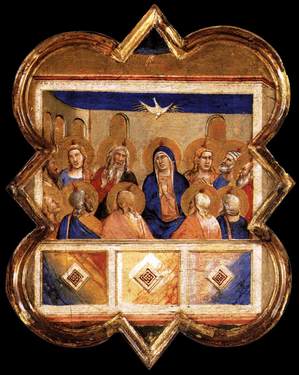One of the things that distinguishes my day is an attempt to recognize the work of the Holy Spirit in my life. Of course, my day is punctuated with praying the Divine Office and the Mass but there are times where I find myself praying the Angelus and the ejaculatory prayer–one liners given by the Church to focus my attention, for example Veni Sancte Spiritus, Veni per Mariam or Saint Joseph, pray for us. The acknowledgement of the Spirit in my life is known pivotally in the fact of the Incarnation: the point in history that that God’s love can’t be kept to Himself that He sends the eternal Word to become man, Jesus born of the virgin Mary.
This very brief prayer is well used by the members of the ecclesial movement Communion & Liberation. We maintain a tradition of concluding our prayer with this keen reminder and request that the Holy Spirit, Who is already present, to allow us to grasp the meaning of God becoming man.
Here are the notes from Father Luigi Giussani’s remarks at the Spiritual Retreat of the Memores Domini, La Thuile, Italy, 2 August 2001
Forgive me if I too come explicitly into your meeting. Because, if the sacrifice of not coming to be with you is united with the joy of being Christ’s, of being His, with a little of this confidence, of this hope-which was born in the heart and which fidelity to the life of the Church has magnified enormously and caused to become adult, mature-then it is not inconceivable that I might talk with you for a few minutes.
 I wanted all the Memores Domini [the group of consecrated lay men & women] to know that there is a formula, an ejaculatory prayer-as all the Church’s tradition calls it-a formula that sums up everything we have tried to believe, express, and communicate, because it is the formula that summarizes all of Christian dogma as the Church has always lived it: Veni Sancte Spiritus, Veni per Mariam (Come Holy Spirit, come through Mary).
I wanted all the Memores Domini [the group of consecrated lay men & women] to know that there is a formula, an ejaculatory prayer-as all the Church’s tradition calls it-a formula that sums up everything we have tried to believe, express, and communicate, because it is the formula that summarizes all of Christian dogma as the Church has always lived it: Veni Sancte Spiritus, Veni per Mariam (Come Holy Spirit, come through Mary).
You will have been struck by lots of things; but guilt is never uprooted from our conscience, the affirmation of the truth is never renewed, if the whole soul does not try to make happen what the cry of the Christian tradition has us say over and over. Veni Sancte Spiritus, Veni per Mariam is the synthesis of everything the liturgical year tells us, it is the synthesis of everything the memory of Christian life tells us.
Because everything, everything comes from the Holy Spirit. It is the Spirit of God who gives the possibility of being struck positively, and even fervidly, by vocation, by the grace of God in life-because vocation is the grace of God in life. It is through the Spirit that every man, like every being, enters into a vast design, as vast as the Father conceived it.
Who knows if the Spirit will grant me still to have a living relationship with you, or better, that the living relationship with you-which will not cease for all of eternity-may still have some direct operative implications in the life of this world.
Veni per Mariam indicates, synthesizes, the finger pointing to everything, everything that our human eye can let us see and that the consciousness can readily understand. Because Our Lady is the synthesis of all humanity… not only of humanity but also of everything that creation brings with it from all eternity, for all eternity. From all eternity everything is the Father’s; in the Mystery every thing was born, every speck of dust, even the grain of sand on the earth, every thought and every feeling man has. Mary synthetically expresses this link between the Mystery and the things the Mystery Himself created (this is why the Holy Spirit is called Redeemer and Savior), because Our Lady is the only possibility of synthesis, in man’s heart, of everything that happens, has happened and will happen, which is faith, which unfolds a hope, and hope makes us live the aurora of the eternal. It makes us live the aurora of the eternal!
Who knows, who knows if the Lord and Our Lady will give me more health and will renew again the energy to communicate things to you, according to an experience that, with time, grows greater and greater, ever greater and greater!
May Veni Sancte Spiritus, Veni per Mariam be a connection that may arouse more quickly in your heart adherence, a certitude of hope, and a beginning of a vision of what the Lord will do for us as the final reward of our life.
Ciao! Until we meet again!


